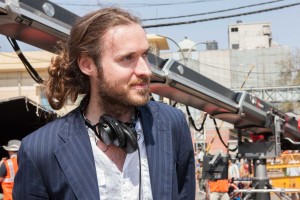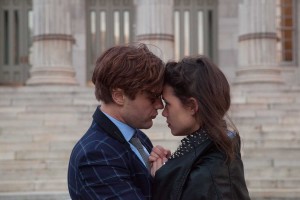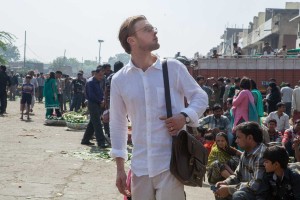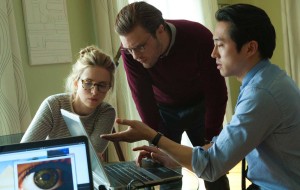
I Origins, writer and director Mike Cahill‘s second feature film, tells the story of Dr. Ian Gray (Michael Pitt), an ocularly obsessed molecular biologist who sees life through only the lens of science. But he meets a young woman, Sofi (Astrid Berges-Frisbey) who is intensely spiritual and experiences a passionate but short lived affair with her. Years later, his cutting-edge research with his lab partner (Brit Marling) yields exciting and revolutionary discoveries that fuses the world of science and faith in an unexpected way that changes everything he ever knew.
Cahill is no stranger to the world of scientific marvels. His first feature, Another Earth explored life on another planet mirroring Earth. The filmmaker wrote the first script of I Origins in only a couple of weeks. He was especially inspired after meeting with Pitt. Cahill found him to be the perfect Dr. Ian Gray so he bound himself to his computer, working out the script until the first draft was finished.

The genesis of the idea to focus on eyes came from the immediate familiarity people sometimes experience upon meeting. “When you look into someone’s eyes, for some people, you feel as if you’ve known them for centuries,” said Cahill. “I wanted to understand that. And the eye has been so fascinating throughout human history. The eye as an organ is something that is unique just to you, me, and everybody…It just seemed like a really wonderful canvas to tell the story about.” Cahill’s approach to science and spirituality was ambitious. He set out in this film to show that the two are not at odds with each other. In fact, the two are harmonious in the story; they tell of humanity.
Telling the story through the editing also fell to Cahill. The process of editing was a seamless transition from writing and directing. “To me it’s one brushstroke of a paint brush. From writing to directing to editing. When I’m directing I’m thinking of the edit constantly. That’s how I can choose what shots, because I know how they’re going to cut together, what we need to cover it,” Cahill explained.
 The cinematography was done by Markus Forderer, a German cinematographer whose aesthetic is similar to Cahill’s. Forderer created a world that is as mystical as the film’s topic and as lush to behold as the beauty of life. When Ian first meets Sofi and gallivants through the streets of New York with her, it is as though the audience is watching a dream unfold.
The cinematography was done by Markus Forderer, a German cinematographer whose aesthetic is similar to Cahill’s. Forderer created a world that is as mystical as the film’s topic and as lush to behold as the beauty of life. When Ian first meets Sofi and gallivants through the streets of New York with her, it is as though the audience is watching a dream unfold.
When it came to the production design, Cahill enlisted the help of Tania Biljani, best known for her work on comedian Mike Birbiglia‘s Sleepwalk With Me. She is originally from Mumbai, India, which helped when it came to creating the complex world of I Origins, which was set in New York and India. Cahill had met with several production designers but as soon as he met her he knew she was the one for the job. “She had a sensibility that was so perfectly dialed into the movie. She felt it in her veins,” said the director. “[Her] suggestions were tactile expressions of the abstract words.” They worked together on textures as a way to ground the audience in the character’s residences so that they would become complete stories of the characters. “It’s in the background, but it forms who these characters are that embody those spaces.”
 Poetic realism is the aesthetic Cahill wanted to go for. Rockefeller University allowed the filmmaking team to use an empty floor to create the laboratory that Dr. Ian Grey worked in. Biljani built the laboratory from scratch. She sourced everything from real laboratories and transformed the space so convincingly that real scientists who visited the set commented on what a great lab it was.
Poetic realism is the aesthetic Cahill wanted to go for. Rockefeller University allowed the filmmaking team to use an empty floor to create the laboratory that Dr. Ian Grey worked in. Biljani built the laboratory from scratch. She sourced everything from real laboratories and transformed the space so convincingly that real scientists who visited the set commented on what a great lab it was.
The role of costume designer went to Megan Gray, a newcomer to the world of designing for films. She created a look that was distinct to each character. The characters in this film weren’t afraid of having a signature look, of repeatedly wearing clothing that suited their personalities. Sofi is found wearing a studded black leather jacket in most of her scenes and it speaks volumes about who she is, of her gumption and her zest for life.
The hauntingly effective original music was composed by Will Bates and Phil Mossman. This was the second time Cahill worked with the two, who also composed for Another Earth. “I find collaborators where you can feel we’re on the same wavelength. I felt that immediately with them. We have a synchronicity. Their tastes align with me.” The director trusted Bates and Mossman entirely and gave them the freedom to create and be imaginative with instruments of all kinds. “I believe in trusting in other people’s geniuses and letting them soar. The team put immense thought into each character and created themes for them.”
As a filmmaker, Cahill faced the challenge of creating a film that was sincere without drowning in sentimentality. “We been living in a post-modern ironic era for some time now, about 30 years, since Warhol and it permeates films too. Somehow we’ve landed in the land of irony where irony defines this generation. It’s very cool, a bit cold, funny, but it makes it very difficult to do sincere stuff without getting pegged as pretentious or a little too earnest. In doing this movie, I’m conscious of the fact that we’re making big statements about the human spirit, big things about love.” As he attempted to make such an audacious film, he kept balance in mind. It would have been easy to step too far into the land of sentimentality. The goal for the director is to push forward beyond post modernism. “I like sincerity,” he says. “But it’s dangerous because you can get laughed at. It can get cheesy. And yet, that’s where the real stuff lives.”





